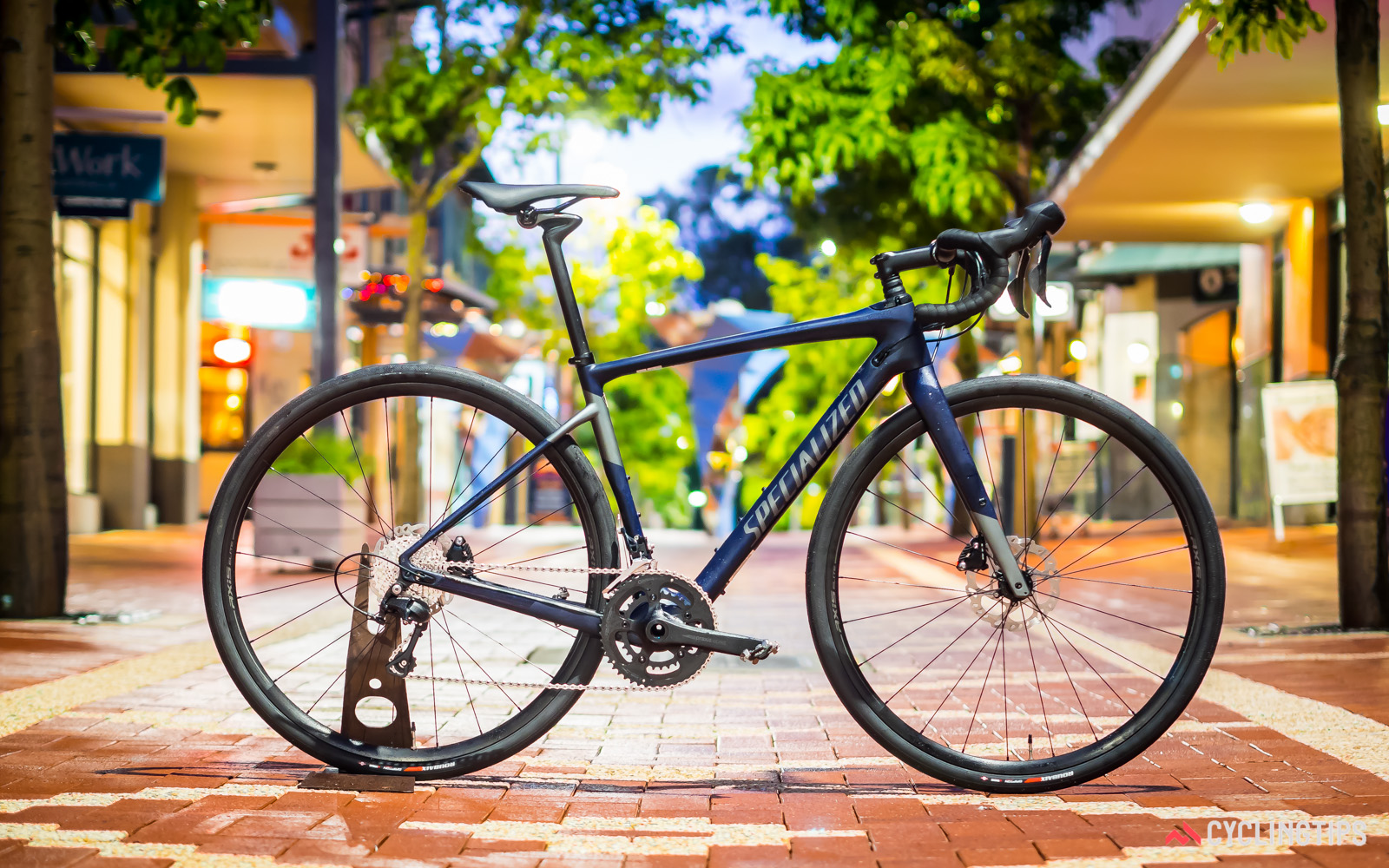
Specialized has updated the Diverge for 2018 with a deeper commitment to the bike’s off-road capabilities. The second-generation Diverge features a re-designed frameset that eschews Zertz elastomers in favour of a Future Shock suspension unit for the stem. There is more room for wider tyres and the geometry of the frame has been refined. And according to Specialized, the new Diverge “re-defines the possibilities of a drop-bar bike”.
In this review, Australian tech editor Matt Wikstrom takes a look at all the changes and assesses the performance of the new Diverge Comp.
It’s been a few years since Specialized launched the Diverge, an adventure-oriented road bike that featured 32C tyres and forgiving geometry for tackling unpaved roads. Specialized never referred to the Diverge as a gravel bike, though, preferring to promote it as a “fully-fledged exploration machine” born out of “new way of thinking about road bikes”.
Rider-comfort was an important priority for the first-generation Diverge. The bikes was equipped with 32C tyres and incorporated the same range of Zertz elastomers found on the Roubaix SL4 for damping vibrations travelling through the chassis. The bike also featured the same Zertz-equipped CG-R seatpost with a shortened seat tube to encourage compliance at the saddle.
While the distinction between the Roubaix and Diverge has always been clear — performance versus adventure, racing versus exploration — the two bikes clearly shared the same kind of thinking and marketing strategy (“Smoother is faster”). So when the Roubaix was updated last year, it seemed likely the Diverge would inherit the same features, should it ever be revised.
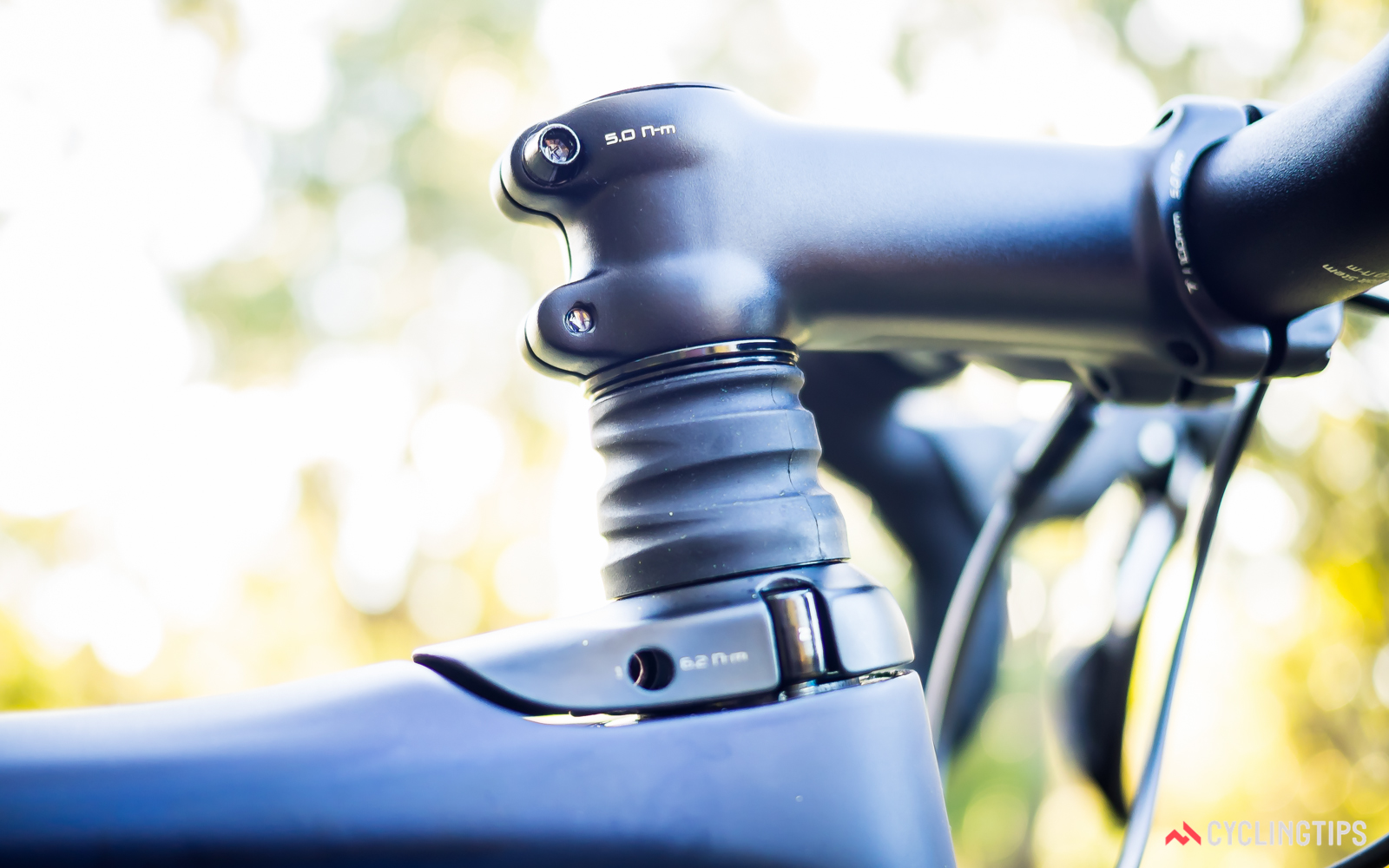
And that’s exactly what Specialized has done for the second generation Diverge, more or less. Most significantly, the company’s Future Shock has been incorporated into the front end of the bike while the Zertz elastomers have been abandoned for all but the seatpost. Tyre clearance has been increased and new frame geometry provides extra stack, shorter reach, and a lower bottom bracket. All told, the result is arguably more comfortable and versatile than its predecessor, which should strengthen the appeal of the Diverge.
Contents
MORE THAN A MAKE-OVER
When placed side-by-side with the first generation Diverge, there’s no mistaking the new bike for the old. Aside from the obvious change under the stem, where the Future Shock now sits, the forks and seatstays now sport clean, straight lines because of the absence of Zertz elastomers. At the same time, where there were once post mounts for the disc brake callipers, now there are flat mounts, which also help to tidy up the lines of the bike.
The top tube on the previous Diverge that flowed cleanly into the seatstays has also disappeared from the new bike. In its place is a thicker, bolder tube with much less slope. The seatstays have been lowered, emulating to some degree the new Roubaix, however the lowered seatpost clamp design from that bike has not been carried over. Instead, there is a conventional clamp at the top of the relatively short seat tube.
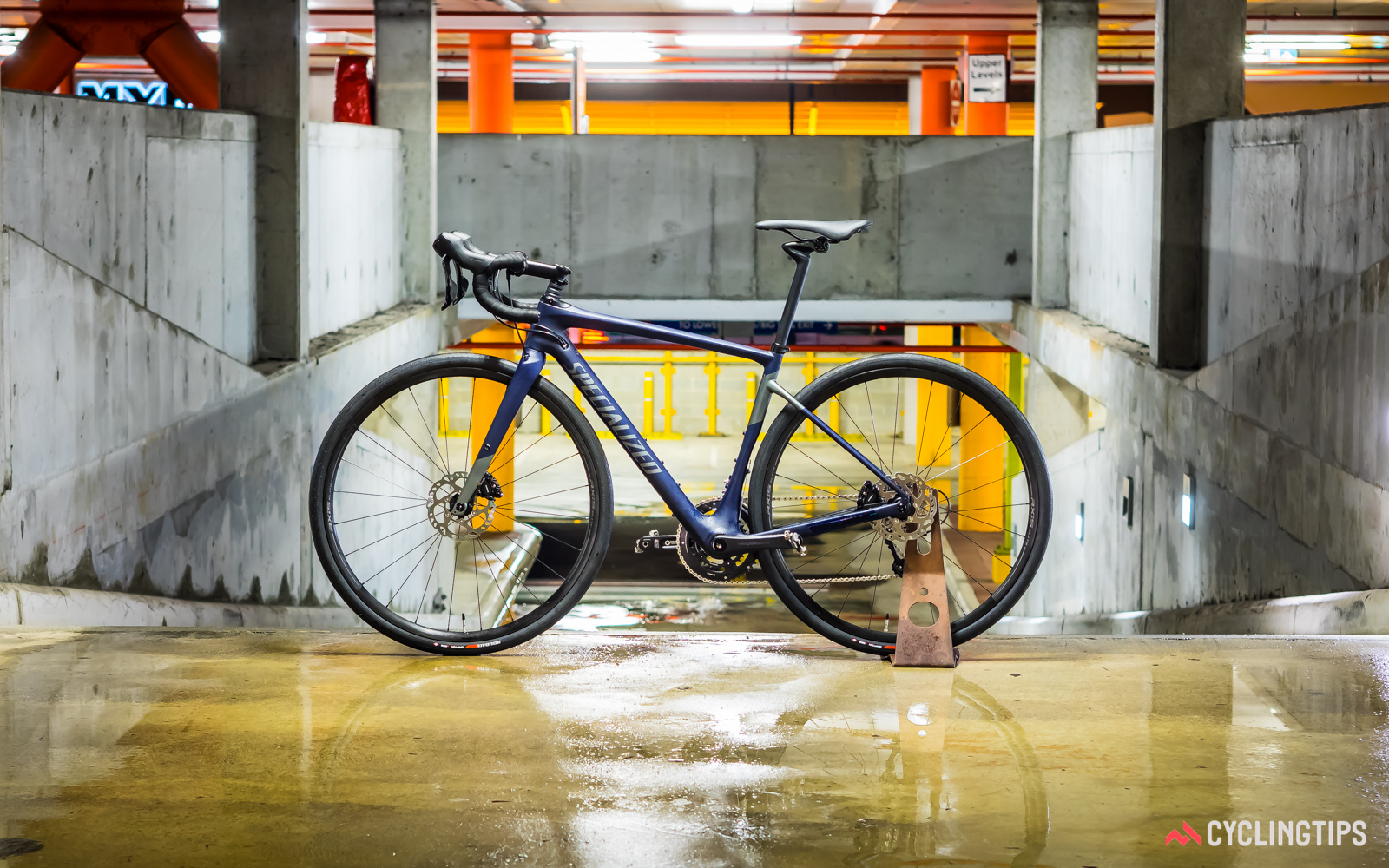
The Diverge still makes use of thru-axles — 12x100mm and 12x142mm for the front and rear, respectively — however Specialized has abandoned its carbon OSBB bottom bracket shell in favour of BB386. Internal routing for the cables and brake hoses has been carried over for the new bike, as have fender and rack mounts, front and rear. And Specialized’s CG-R seatpost continues to be offered with the bike, too.
As mentioned above, the new Diverge has extra tyre clearance, now allowing for tyres up to 42mm wide (up from 35mm) when using a 700C wheelset, or, 47mm when using a 27.5inch/650b wheelset. As such, the second-generation Diverge is keeping pace with the current trend towards wider tyres, especially for gravel riding.
Specialized used its FACT 10r carbon fibre to construct the first-generation Diverge frameset; in contrast, the 9r blend is used for the new frame. The step down in modulus provides a minor increase in vertical compliance and adds a little weight to the frame.
FUTURE SHOCK
With a period of five years devoted to the genesis of Future Shock, it’s not really surprising that Specialized has decided to incorporate it into other road bikes in its collection. And as a dedicated adventure bike, the Diverge would seem a logical candidate for the new suspension system.
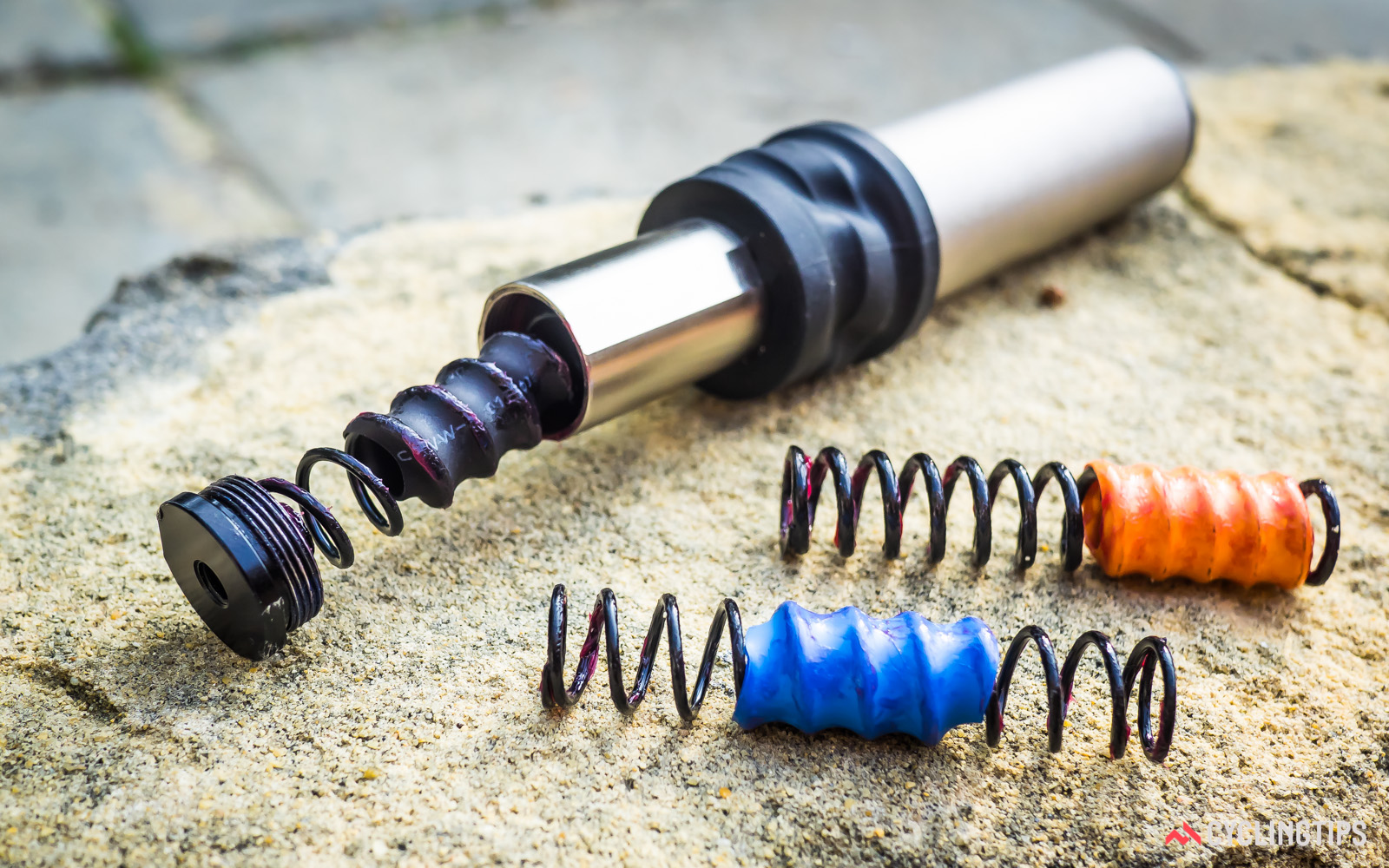
The upper spring of the Future Shock can be swapped out by owners to change the response of the unit. Specialized provides three springs — blue, black and yellow — that differ in weight and affect how readily the shock will compress.
For those unfamiliar with the Future Shock, it takes the form of a small shock unit. The outer tube is positioned within an oversized fork steerer while the stem attaches to the telescoping inner tube. As weight is applied to the bars, the Future Shock compresses and the entire stem travels downwards in a near-vertical path.
The Future Shock offers 20mm of travel. Three springs are arranged within the unit to control compression and rebound. According the Specialized, a series of springs is better suited to road chatter than more sophisticated systems, plus, it saves weight and owners won’t be frustrated by stiction. The Future Shock used for the new Diverge differs from the units installed in the Roubaix and Ruby in that a “progressive spring” is used that is better suited to the demands of mixed terrain riding.
There are no adjustments on the Future Shock for pre-load, compression or rebound. The only way to adjust the behaviour of the unit is to swap the upper spring. There are three to choose from — firm (yellow), medium (black), soft (blue) — but because every unit leaves the factory with a firm upper spring installed, the extra springs are only of value to those owners hoping to soften the front end.
Swapping out the upper spring is a relatively simple process. First, the stem must be removed, including the shim that sits over the inner tube of the unit. Second, a 20mm wrench is required to loosen the top cap of the unit. And third, once the cap has been removed, the spring can be pulled out and replaced. The whole process takes just a few minutes and the impact of each spring can be easily felt in how readily the unit compresses.
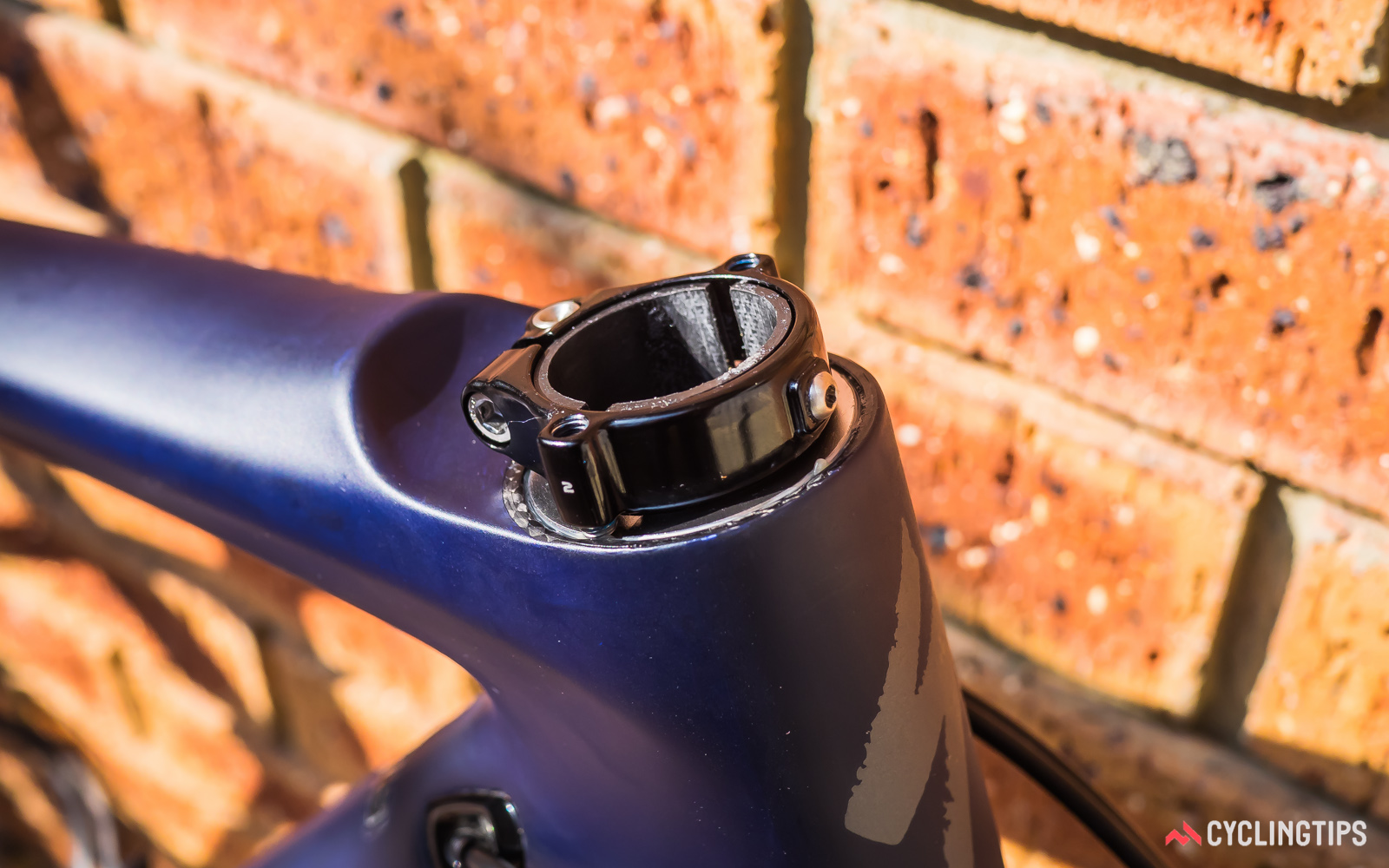
While the front end of the new Diverge continues to use a largely conventional threadless headset, the stem no longer attaches to the fork steerer. As a result, stem height is adjusted by sliding the whole Future Shock unit up or down within the fork steerer.
There is a choice of top caps for the upper headset bearing — slim or tall — to which standard headset spacers can be added to set the height of the stem. There is a limit to how far the Future Shock unit can be raised — 30mm — and while the minimum insertion is clearly marked on the Future Shock unit, some may unknowingly exceed it because it is hidden beneath the top cap and spacers.
A maximum of six 5mm spacers can be added to the slim cap, while just three can be used with the tall cap.
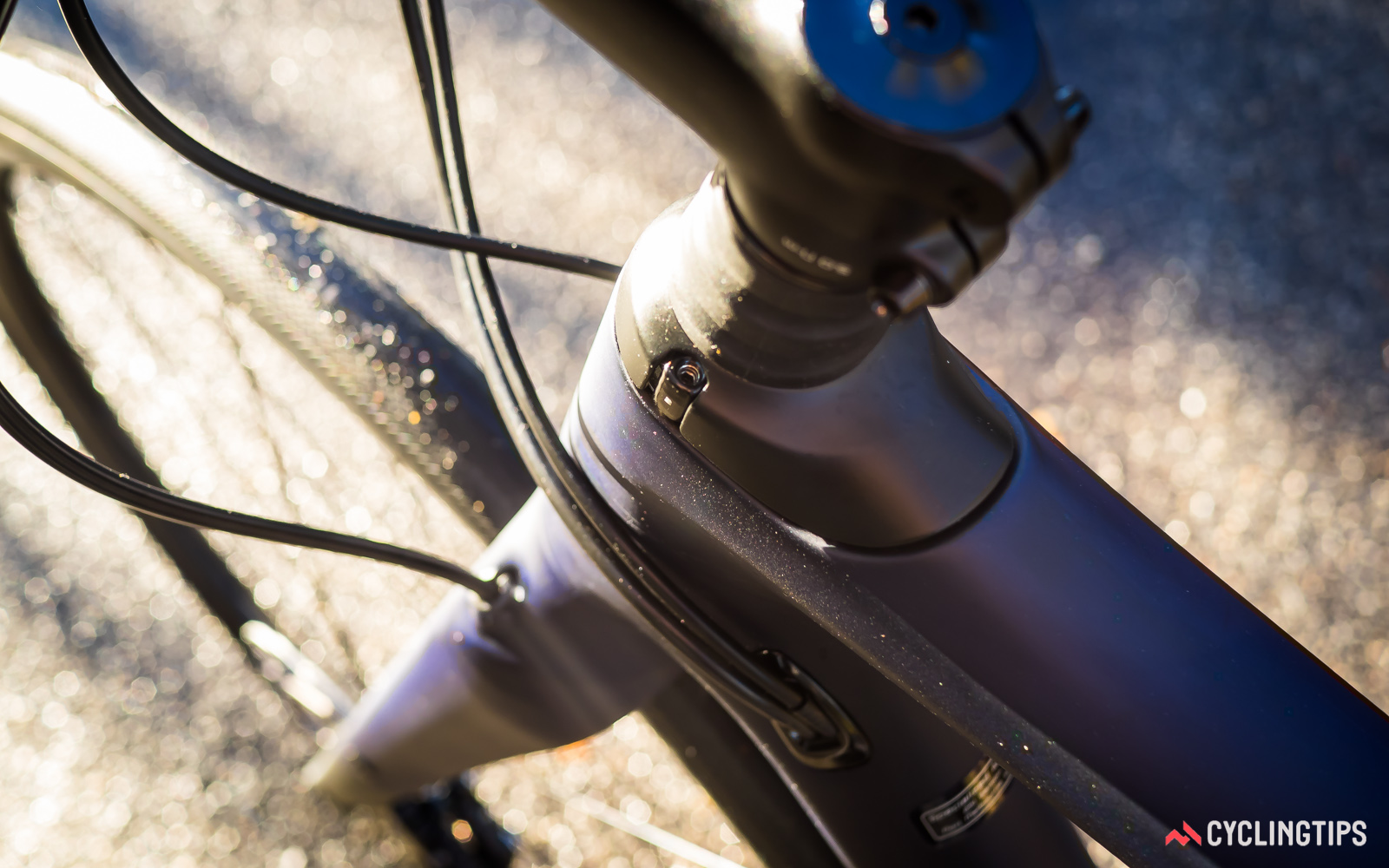
A pair of grub screws are used for adjusting the headset, one on each side of the cap. There’s actually two screws in this hole: a lower screw (hidden) is used to adjust the tension on the bearings, while the upper screw locks down onto it to stop it from coming loose.
Adjusting the headset is a different matter altogether. There is no center-bolt for compressing the bearings; instead, there is a pair of grub screws, one on each side of the top cap (see photo above). These adjusting screws act directly on the compression ring for the upper bearing, increasing the pre-load on the headset as they are tightened. A second locking screw tightens down onto each adjusting screw in order to stop it from coming loose.
This system is not especially elegant, and since there is no way to tighten the adjusting screw against the locking screw, there’s a risk that both will rattle loose, especially on rough terrain. As result, owners may have to resort to applying a threadlocking compound to each locking screw if they have ongoing problems with the headset coming loose.
GEOMETRY AND BUILD
The overall geometry of the second generation Diverge can be described as taller, shorter and lower when compared to its predecessor. The stack of the new bike has been increased by 20-43mm (depending on the frame size), due primarily to the addition of the Future Shock, while the reach of the bike has decreased 8-18mm. The Diverge Comp continues to be offered in seven frame sizes, as shown in the table below:
It’s worth noting that the head tube length and stack measurements include the Future Shock. The bottom bracket drop has been increased to 85mm for all frame sizes while the chainstays are 3-7mm longer (419-423mm, increasing with frame size) and the head angle a little slacker when compared to the first-generation Diverge. The two smallest frame sizes are paired with a fork with 55mm of rake while all sizes make use of a fork with 50mm of rake.
It’s worth noting that the Diverge Comp is supplied with a riser handlebar that adds 15mm to the stack at the front end. When coupled with the generous stack and short reach of the bike, it produces a very tall front end. This will make it very easy for riders striving for an upright position while those looking for a more aggressive position may have to resort to a standard bar and/or an inverted stem.
The new Diverge looks a lot like a contemporary compact road bike, but for those that like to see the stem slammed against the headset, the Future Shock will be something of an eyesore. To my eye, the rubber boot that protects the shock looks like an untidy stack of spacers. The crooked seatpost also threatens to interrupt the otherwise clean lines of the bike.
Be that as it may, the new Diverge is not an ugly bike. Compared to the original design, the new frameset is arguably racier and does an admirable job of concealing what is an obviously tall front end. Before riding the bike, I would have been quick to dismiss the unconventional features as blemishes, but having found that both the stem and post perform as well as Specialized claims, I’m willing to forgive both in the name of function.
The new Diverge range comprises several models including a S-Works version with a frame that weighs a claimed 880g as well as E5 models with an aluminium frame. For the Australian market, buyers will have a choice of the Diverge Comp (RRP, AUD$4,000/US$3,000/€2,600), Diverge E5 Comp (AUD$2,400), and the Diverge E5 Sport (AUD$1,500).
Many of the new Diverge models will be offered in both men’s and women’s versions, but while Specialized have previously developed gender-specific geometries for many of their bikes, they’re diverting from that approach with the new Diverge. Armed with over 40,000 sets of digitally collected position files from fit partner Retül, Specialized engineers have instead determined that a single gender-neutral frame geometry can work just as well.
Going forward, that approach will likely be applied to all of Specialized’s men’s and women’s bikes.
That doesn’t mean the bikes will be fully unisex, however. Aside from varied frame colours and finishes, the men’s and women’s lines will feature gender-specific touch points. Women’s versions will be available in a smaller range of sizes (48-56cm) with a women’s-specific saddle, and the cranks, stem, and bars will tend to be smaller/narrower. In addition, women’s versions of the Diverge E5 will include an extra-small 44cm size. Unisex versions, meanwhile, will go all the way up to a 64cm size to accommodate especially tall riders.
The Diverge Comp supplied for this review was equipped with Shimano’s 105 hydraulic brake/shift levers, flat mount callipers, front derailleur, mid-cage rear derailleur, and 11-32T cassette. Praxis supplied its Alba crankset made from forged alloy with sub-compact chainrings (48/32T) while the remainder of the parts were provided by Specialized: an Axis Elite wheelset with alloy rims fitted with tubeless-ready Roubaix Pro tyres (32C), alloy stem and bars, and a Phenom saddle.
The total weight for the Diverge Comp sent for review (size 54) was 9.22kg without pedals or bottle cages. That’s close to the norm for a gravel bike but a lot heavier than most road bikes, especially those with a carbon frameset. The first-generation Diverge Comp that CyclingTips founder Wade Wallace reviewed in 2014 was two sizes larger yet it weighed 8.2kg with pedals. I didn’t have a sample for direct comparison, but I expect the extra weight of the new bike can be attributed to Fact 9r carbon fibre, the Future Shock, 105 components, and the forged alloy crankset.
FUTURE SHOCK HAS A LOT TO OFFER
I will freely admit that I had major reservations about the Future Shock system. The idea of the stem bouncing around under load unsettled me, so I was quite surprised, and a little sheepish, when I found myself marvelling at how well the Future Shock system worked.
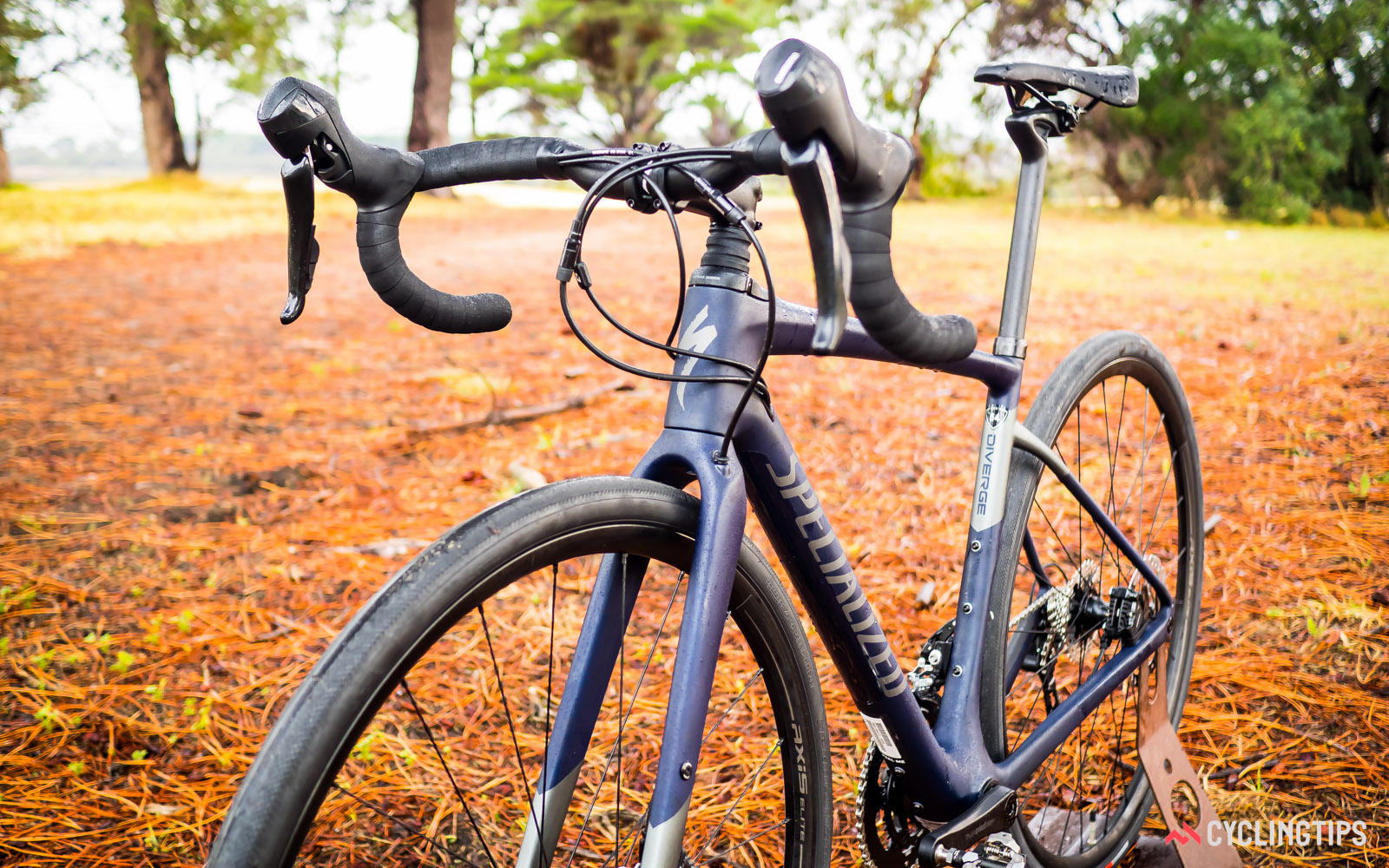
On paved roads, the front end felt very plush, and it was a pleasing sensation. When coupled with the CG-R post, there was ample compliance, front and rear, and the Diverge seemed to glide over the surface of the road. It reminded me of the time I spent in a Cadillac limousine: the chassis gently swayed throughout the course of the journey and I felt like I was being cradled in the arms of a loving parent.
That’s not to say that the Diverge was completely lacking in feedback. The Future Shock took the edge off a lot of sharp hits but never concealed them. Similarly, the seatpost smoothed out the sensations arriving at my backside, but I still had an understanding of the road surface.
One of the immediate benefits of all that extra comfort was that I could stop subconsciously scanning the road surface to find the smoothest line. The Diverge consistently soaked up all of the insults, leaving me confident that it would make a fine choice for any shopper looking for true all-day comfort.
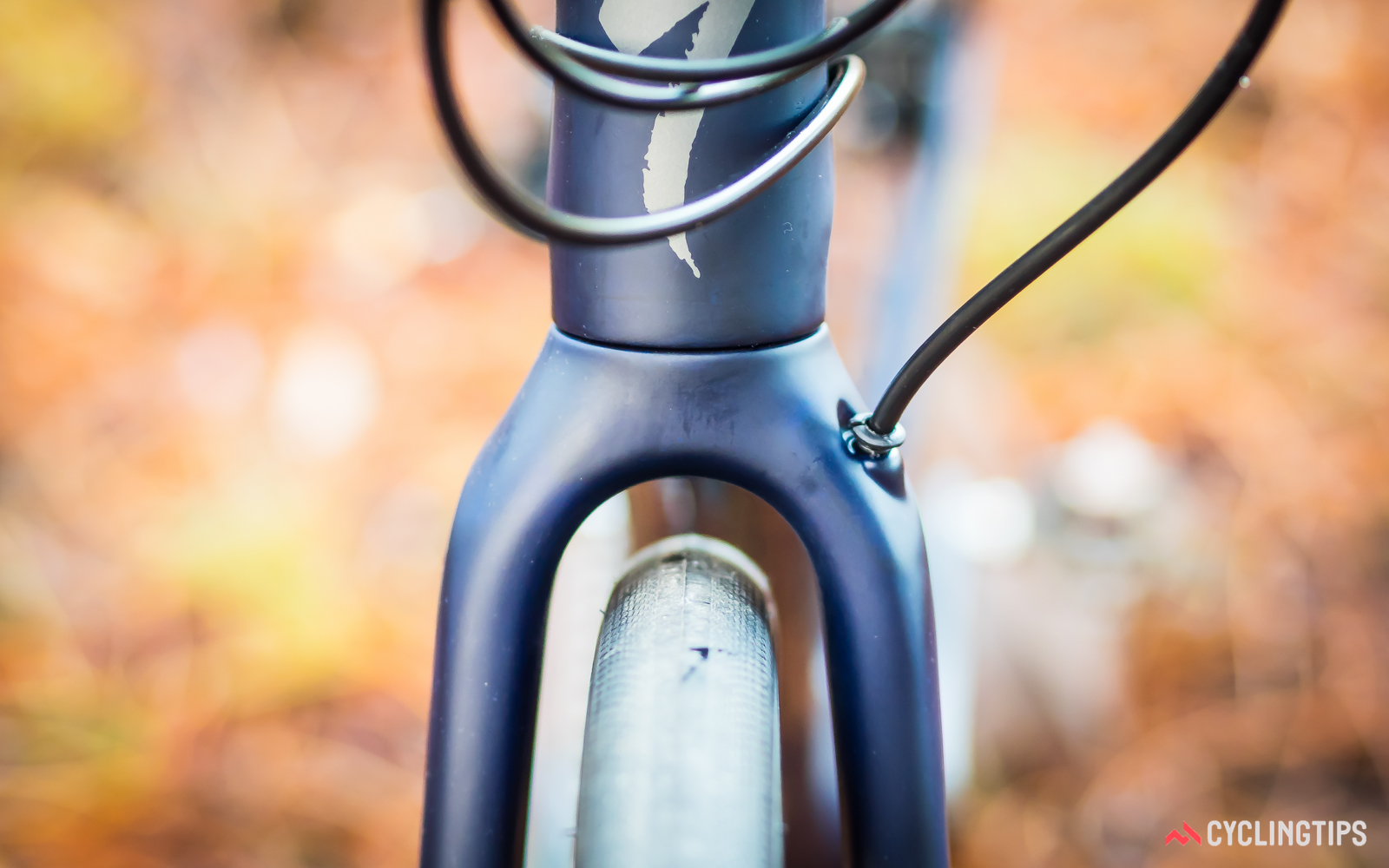
Tyre clearances has been increased under the fork of the new Diverge.
Perhaps one of the best features of the Future Shock was how it could soak up hits while I was out of the saddle on unpaved trails and paths. Rocks and holes were much less likely to upset my rhythm, so I could maintain my momentum. It was perhaps the most convincing example that “smoother is faster”.
There was a limit to how much comfort the stock Diverge Comp could provide, though. While I could ride groomed trails and paths in plush comfort, the Diverge couldn’t do a lot to smooth out rocks, ruts, and corrugations as I tackled gnarlier terrain. Admittedly, this is the kind of terrain best tackled with a MTB, so I wasn’t really surprised. Nevertheless, I was able to enjoy at least an hour in this kind of terrain before it started to take a toll on my body.
I spent my first week on the Diverge using the firm spring in the Future Shock, and in many ways, it provided an ideal introduction to the system. Yes, the bars would dive when I was out of the saddle cranking hard on the pedals, but they never bobbed about erratically. Rather, the motion was generally limited to a subtle dip-and-sway.
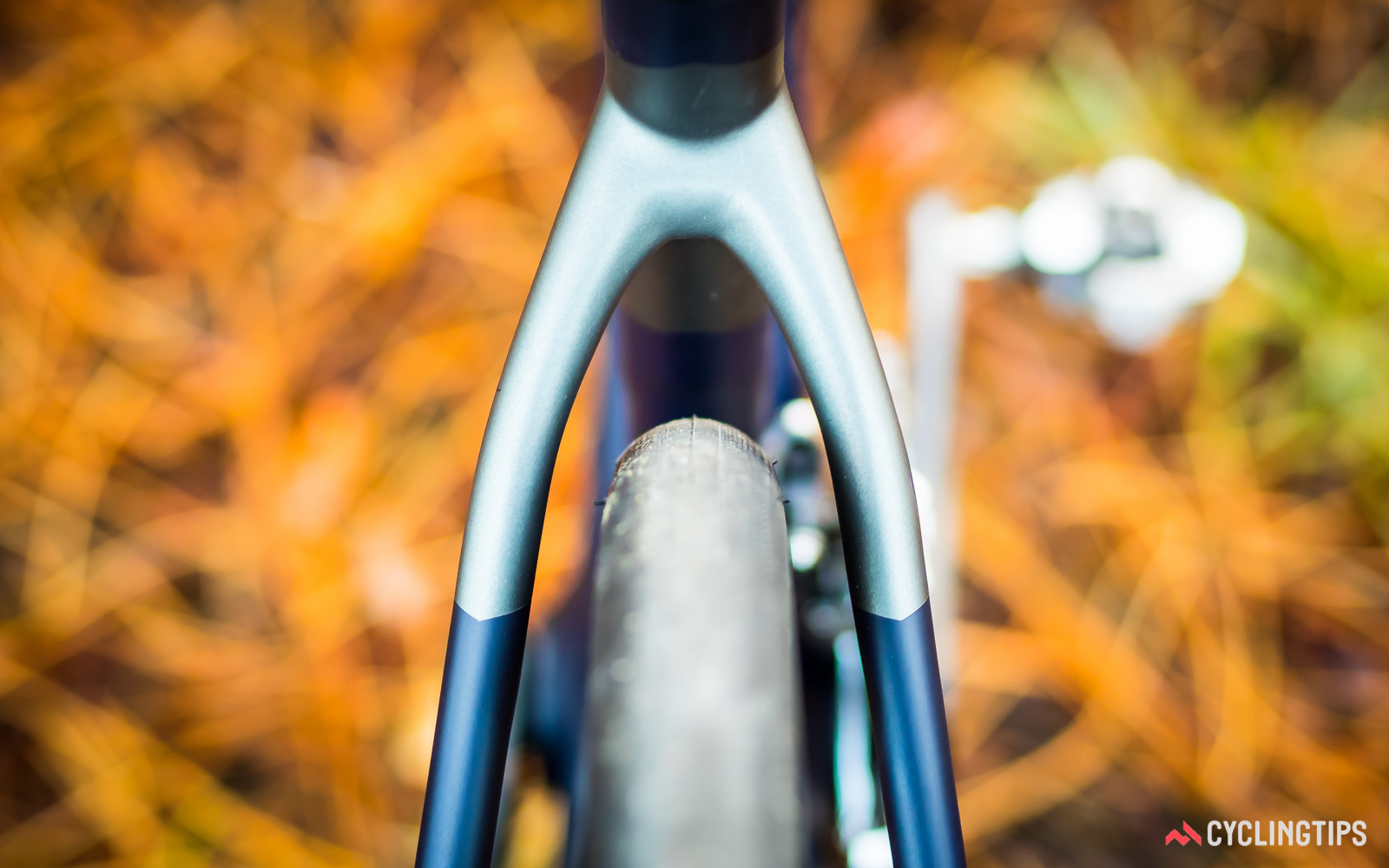
Clearance has also been increased for the rear tyre, making for a maximum of 42mm with 700C wheels and 47mm with 650B wheels.
On the downside, I noticed that the Future Shock was quite insensitive to small, sharp hits. The front end would rattle about much like a conventional road bike, so I started experimenting with the lower weight springs.
The soft spring worked brilliantly for soaking up ruts and corrugations, but for my weight (~77kg), there was a lot of bobbing under load. As a result, the front end felt erratic and almost volatile, on- or off-road. Interestingly, while the bars were quick to bottom-out, I was never aware of the same kind of sharp impact that is normally felt when a suspension fork bottoms-out.
The medium spring proved to be the Goldilocks option for me. I could enjoy a reasonably sturdy front end yet it remained quite sensitive to short, sharp hits. And as a result, it added to the general plushness of the Diverge.
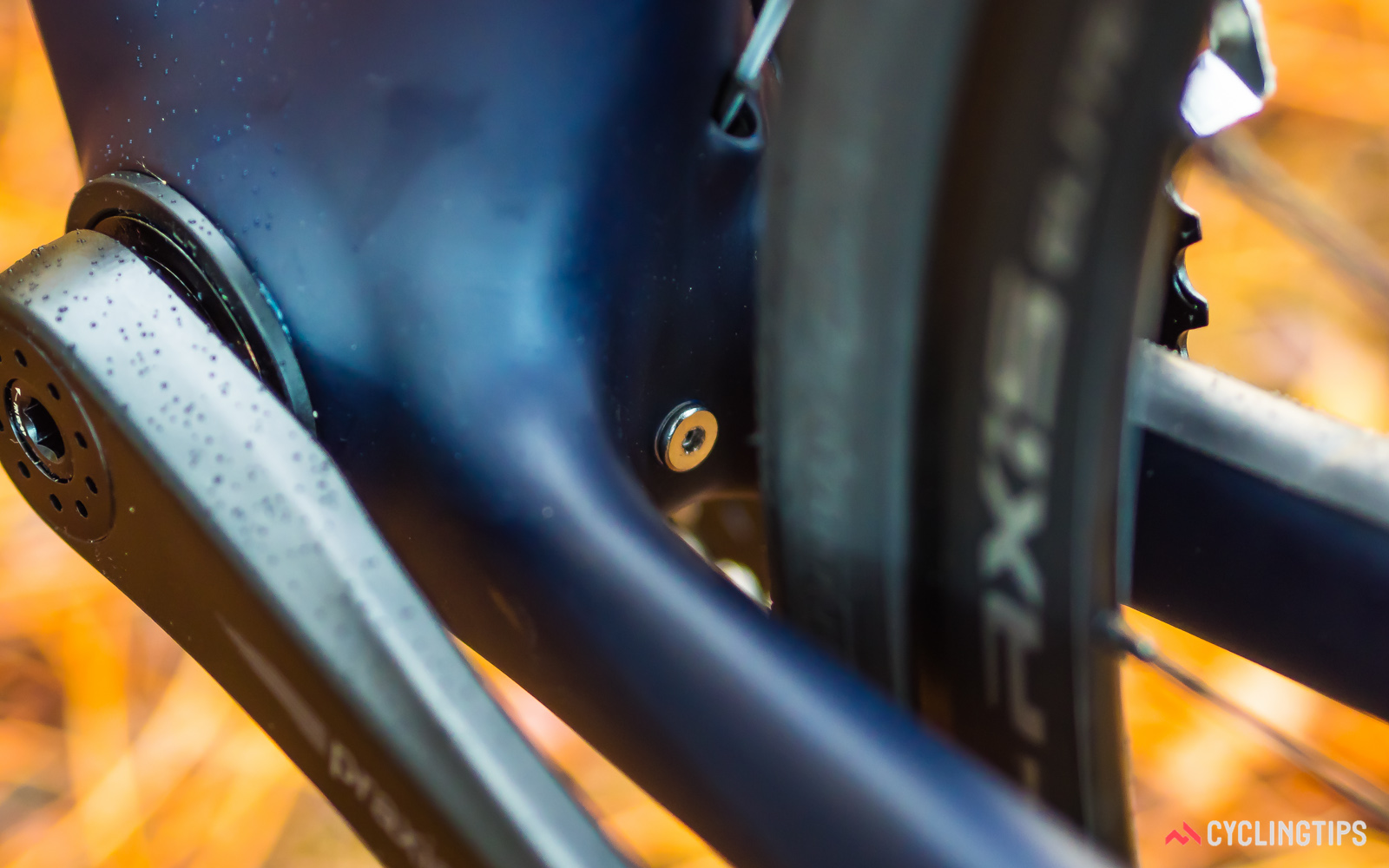
There are mounts for fenders, front and rear.
As I spent more time on the Diverge Comp, the action of the Future Shock started to feel more natural. Indeed, there were times when I had to watch the boot under the stem to convince myself that the shock was actually compressing. And where once I was concerned the system would unsettle my confidence, I discovered that it actually encouraged it, especially when I was riding off-road.
DON’T FORGET ABOUT THE SEATPOST OR THE TYRES
While I was impressed with the Future Shock, it was just one part of the bike that contributed to the plush comfort of the Diverge. The seatpost was an important part of the combination, as were the tyres.
This is not the first time I’ve experienced Specialized’s CG-R seatpost, but it was obviously more compliant, which I can only attribute to the shorter seat tube of the Diverge. Riding a 54cm with a relatively high saddle (768mm) meant there was a long length (~250mm) of the post exposed. The post flexed visibly under load, and in fact, I had to raise my saddle an extra 4mm and adjust the angle of the saddle to compensate for the “sag”.
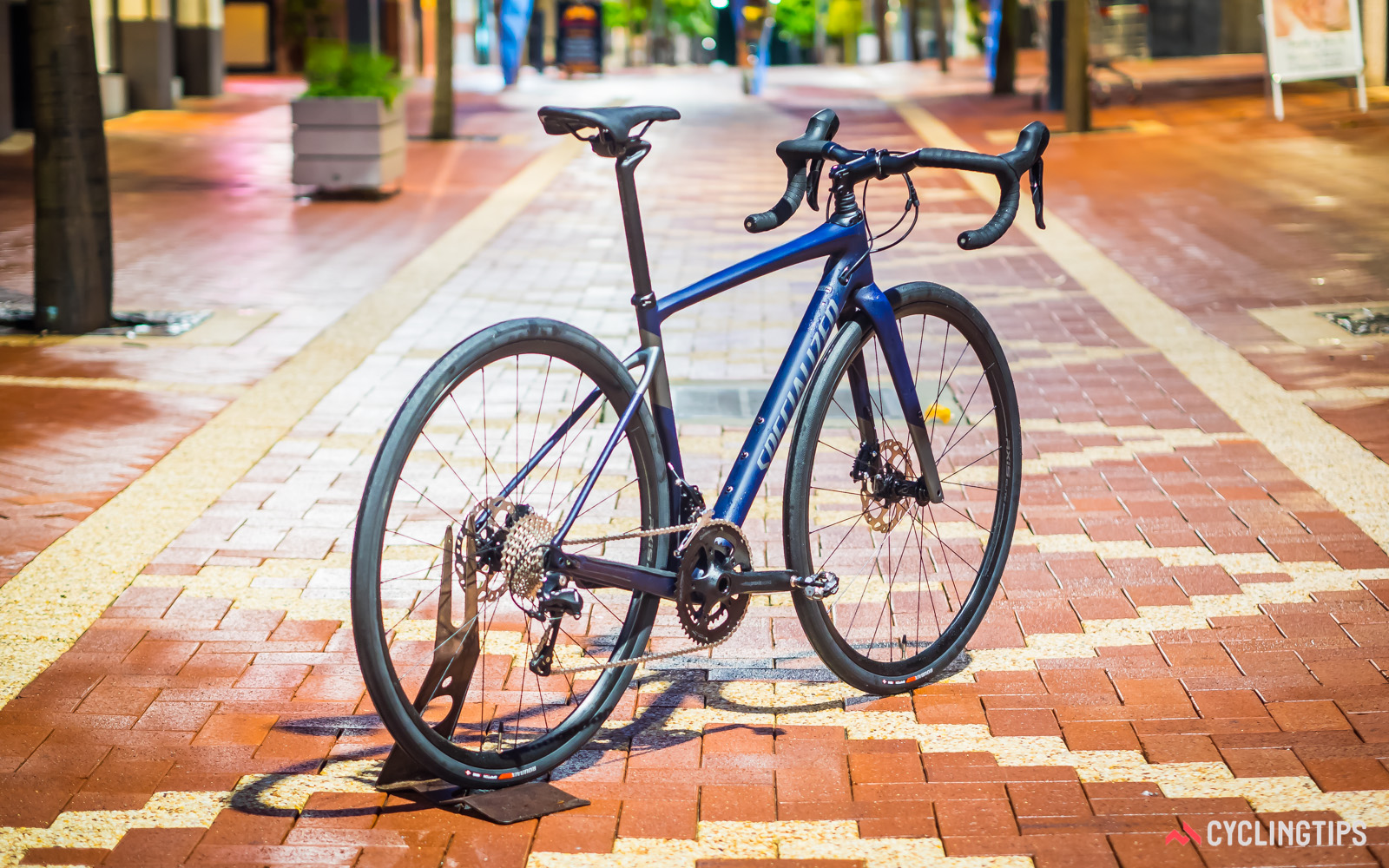
Swapping the CG-R for a standard alloy post demonstrated just how much extra compliance was on offer. I experienced a marked increase in feedback from the road and trail. At the same time, the saddle was noticeably sturdier. While I felt more effective when making an effort from the saddle, one long off-road ride was enough to dissuade me from continuing with the alloy post. I much preferred the comfort of the carbon CG-R post.
I did the same kind of experiment with the tyres to demonstrate just how effective they were, too. Swapping the 32C Roubaix Pro tyres (that were 35mm wide at 50psi) for a set of 23C tyres (25mm wide at 80psi) transformed the Diverge from plush to harsh. In absolute terms, the Diverge wasn’t the stiffest bike I’ve ever been on, not even close, but the contrast was just as profound.
The motion of the bars and saddle was perhaps more obvious while riding on the skinny tyres, yet both felt less effective. In fact, the swaying saddle and bobbing bars became something of a distraction.
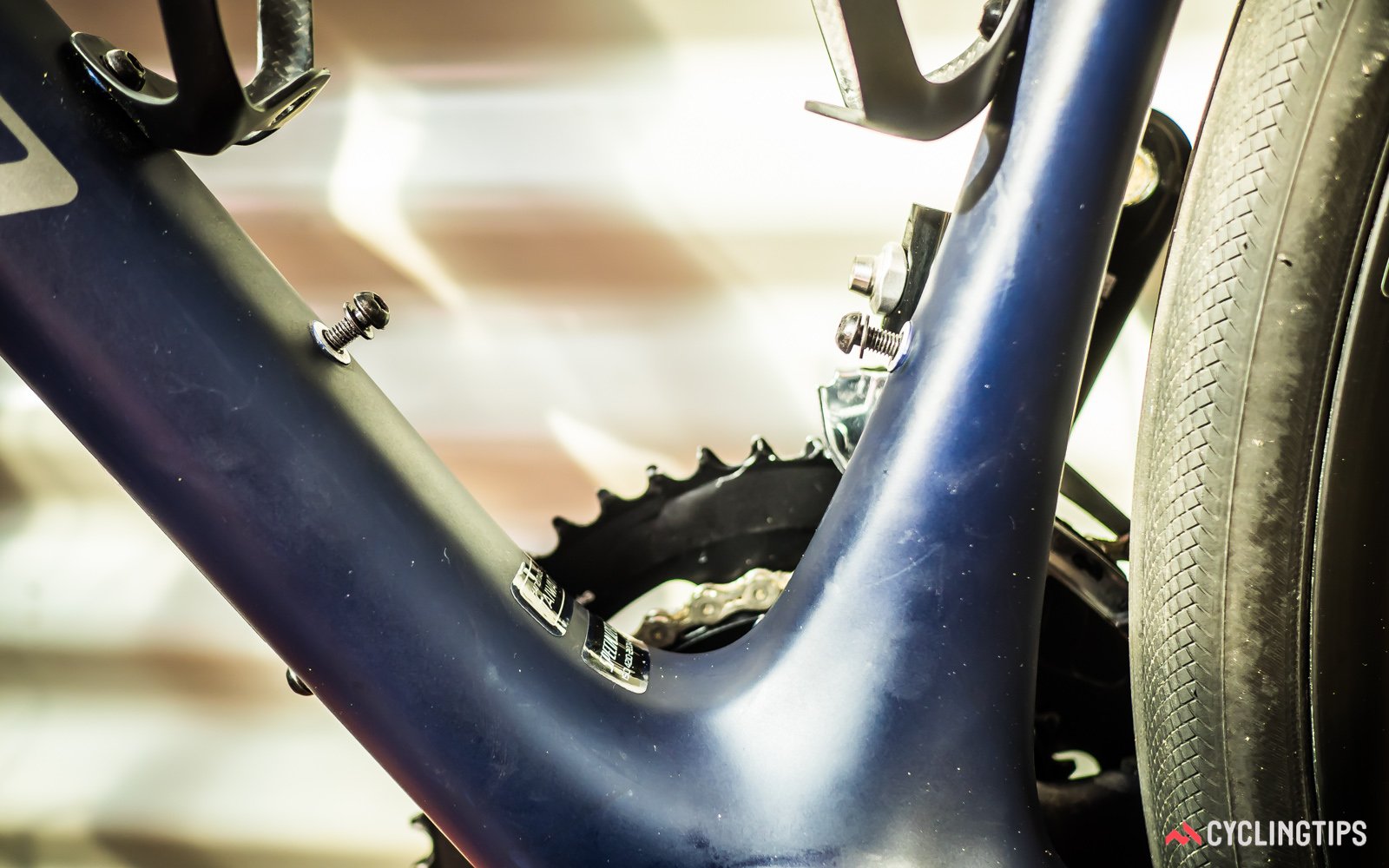
The results from these simple experiments proved to me how well how well different parts of the Diverge worked together to provide a plush ride. While the 32C tyres contributed a lot to the comfort to the bike, the Future Shock and CG-R seatpost both added to it. With room to mount even larger tyres, I see plenty of scope for tuning the ride quality of the bike to suit the rider’s needs and chosen terrain.
THE REST OF THE BIKE
The steering and handling of the Diverge was well suited to riding a mixture of terrain. On paved roads, the bike wasn’t quite as manoeuvrable as a dedicated road bike, but it was still pretty good. It was remarkably stable at high speeds and very well mannered, yet it didn’t take a lot of effort to guide the bike through technical corners and descents.
Off-road, there were times when the steering proved to be a little too quick, though it was only really obvious at low speeds when over-steer was a problem. At high speeds, the stability of the bike was very welcome and I had a lot of freedom to adjust my line as I picked my way through the various obstacles (rocks, holes, and ruts) that typically litter unpaved paths.
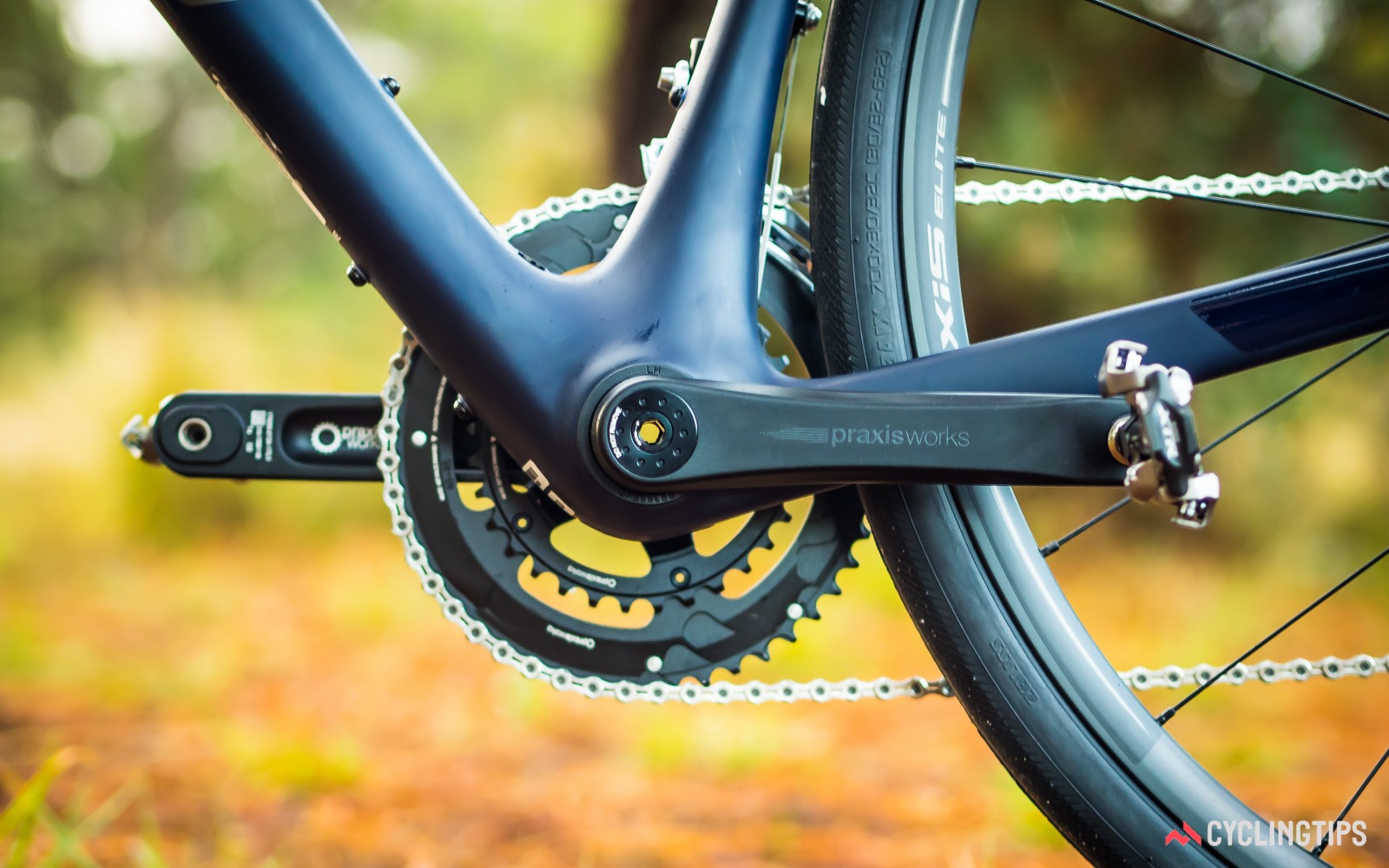
Specialized started offering sub-compact cranks with the original Diverge and continues to do so for the second-generation.
The Roubaix Pro tyres worked well on- and off-road, though it’s important to note that I was riding at a pretty forgiving time of year. Recent rain and low temperatures made for tacky conditions, so I always felt confident riding the near-slick tyres on unpaved surfaces. Indeed, a switch to a set of 32mm cyclocross tyres didn’t do much to improve the grip and traction of the Diverge.
Ultimately, tyre choice will be dictated by local conditions, but on this occasion, the Diverge was close to perfect for riding a mixture of terrain. On paved roads, the Diverge was a capable performer that was best suited to steady efforts, while off-road, there was plenty of compliance and control on offer for tackling reasonably demanding terrain. Importantly, both could be achieved without a change of tyres or tyre pressure.
I did struggle with a series of punctures though, all of which could have been avoided by dumping the stock tubes and going tubeless. The tyres and rims are tubeless ready, so buyers will only need a pair of tubeless valves, sealant, and perhaps some adhesive rim tape.
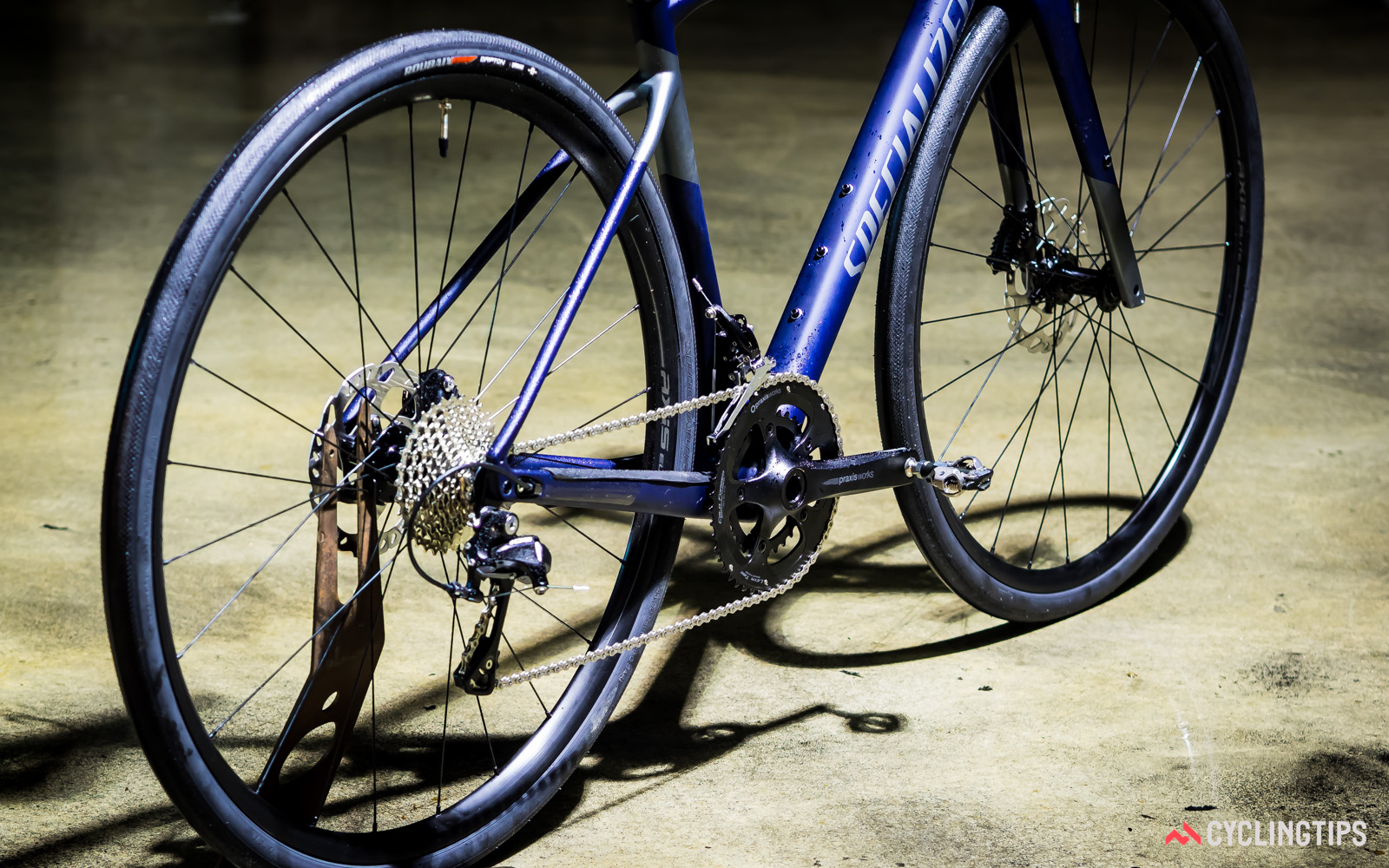
The tubeless-ready tyres were reluctant to seat properly at low pressures, so any time I suffered a puncture, I had to put up with a hop in the tyre until I returned home where I could use a track pump to finish off the job properly. For those that see themselves continuing with inner tubes, a change to standard clinchers should solve this problem.
The Diverge did an admirable job of hiding its weight. Yes, it was slow to accelerate when compared to a race bike, and yes, more effort was required on any slope. But overall, the bike was far less cumbersome than what I was expecting based on its weight and my experience with other gravel bikes.
The geometry of the Diverge probably helped in this regard, but I also suspect that the gearing of the bike had something to do with it, too. The sub-compact crankset (48/32T) paired beautifully with the 11-32T cassette to provide a wide range of gear ratios that were perfectly suited to the larger diameter of the 700x32C tyres and the weight of the bike.
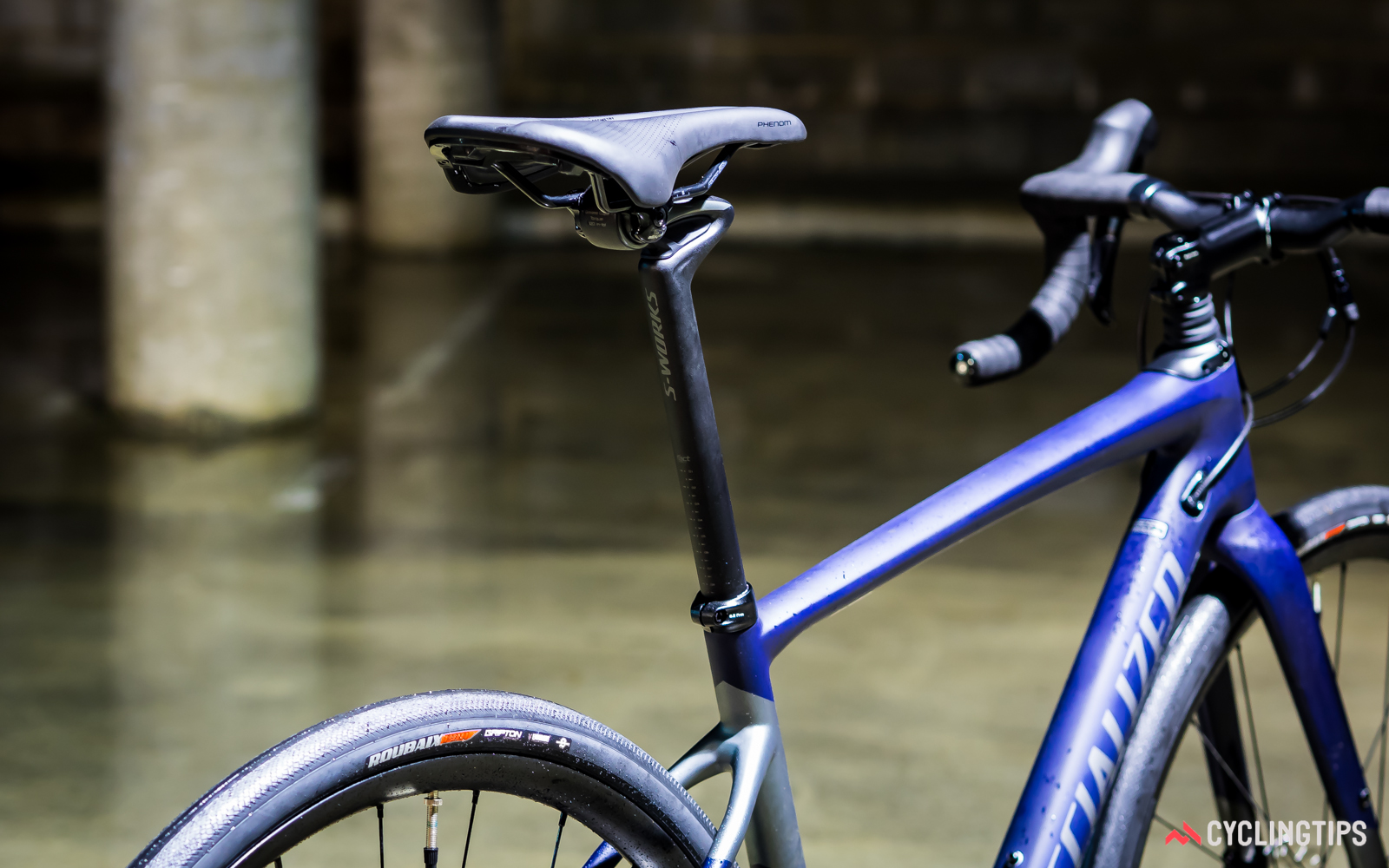
On mildly undulating off-road terrain, I was able to use the big ring for all but the steepest pinches, providing the simplicity of a virtual 1x transmission. And yet, I still had the advantage of the small ring for long climbs and steep walls where the 32x32T allowed me the luxury of staying in the saddle. It was enough to alter my stance on the value of 2x transmissions for gravel riding, which up until now, has been biased towards 1x setups.
While I had my reservations about the system of grub screws for adjusting the headset (see above), I didn’t have any problems with it coming loose during the review period. In fact, I was satisfied with the whole package. There were no shortcomings in the performance of the bike but with an asking price of AUD$4,000/US$3,000/€2,600, the build lacks value, and buyers are going to need a lot faith in the Future Shock to accept the extra expense.
That’s not to say that such faith won’t be rewarded. As I’ve discussed above, the Future Shock does add to the performance of the bike, and compared to its predecessor, it is improved in terms of its versatility and off-road capabilities. For those looking for extra value, the Diverge E5 Comp or Sport have more to offer, though the build kits are a lot more modest (e.g. cable-operated disc brakes), and the E5 Sport lacks the Future Shock.
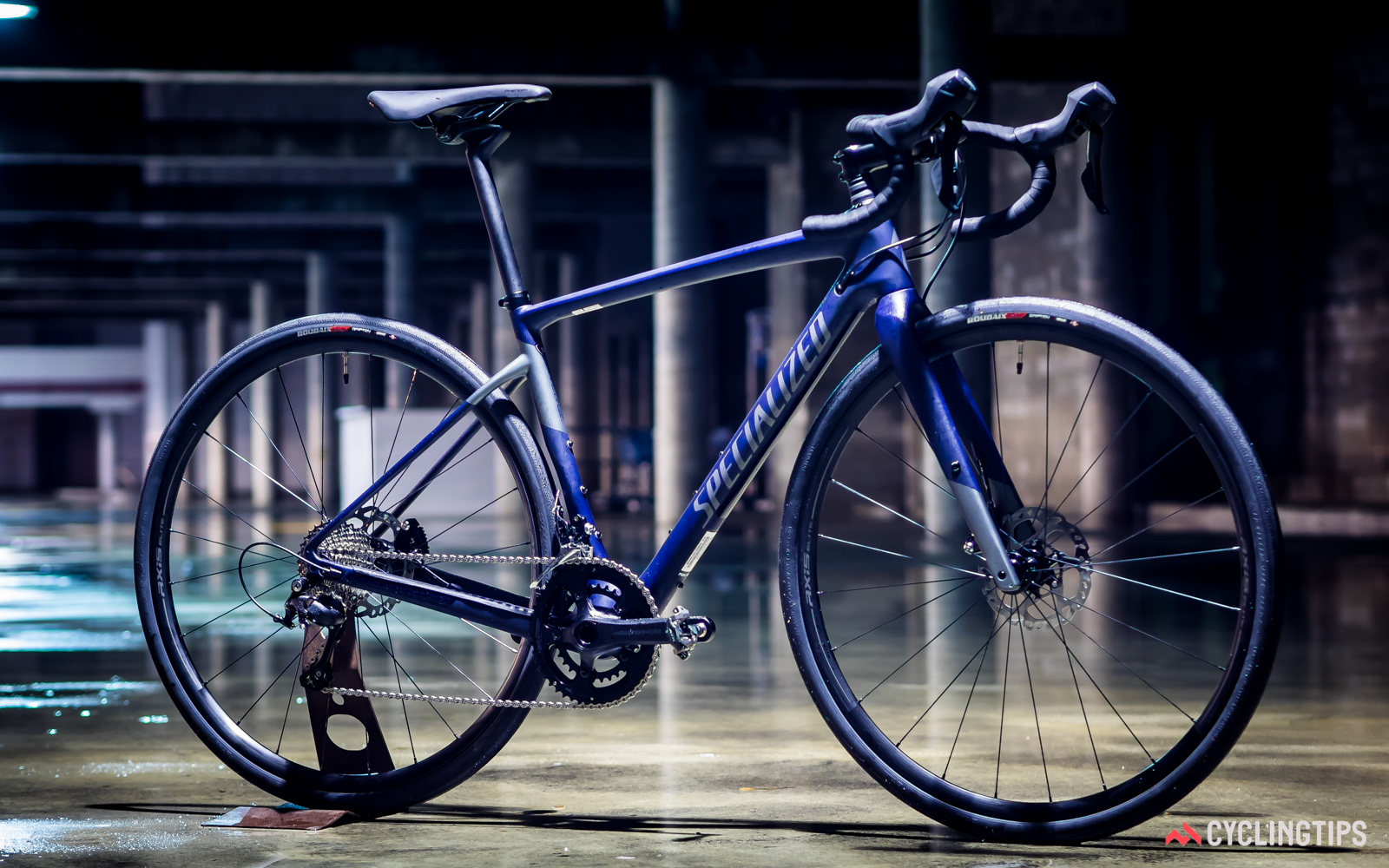
SUMMARY AND FINAL THOUGHTS
Specialized has done a great job with the new Diverge. On- or off-road, it has a lot of comfort to offer, and while it was possible to find terrain that could overwhelm its capabilities, it was remarkably versatile. For some buyers, the Diverge might be a problem-solver, while for others it may create some as they try to justify the addition of another bike to their collection.
When Wade reviewed the first-generation Diverge, he discovered that it was the “the bike I didn’t know I wanted so bad.” For him, there was magic in the way that it could extend the capabilities of an otherwise traditional road bike without a raft of unwelcome compromises. The second-generation Diverge successfully builds upon this theme, adding a new level of comfort and control with the addition of the Future Shock and room for wider tyres.
The new Diverge adds to the growing number of highly versatile road bikes. Examples include Cannondale’s Slate and 3T’s Exploro, Trek’s Domane, Canyon’s Endurace CF SLX, Pinarello’s GAN GR-S Disc, and BMC’s Roadmachine. All represent variations on some common themes but what I find most interesting is that appreciation for suspension elements seems to be growing for gravel bikes.
Based on my experience with the new Diverge, I can see enormous potential in this thinking. The Future Shock may not have a place on a conventional road bike, but it may start shaping new expectations for adventure bikes with drop-bars.
[“Source-ndtv”]
